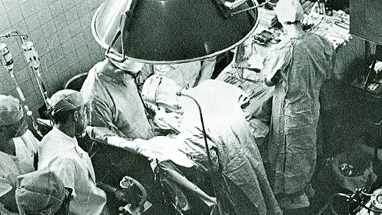-
#ThrowbackThursday 1965: Ten Years Since First Open Heart Operation
This article first appeared March 26, 1965 in the publication Mayovox.
Development of Heart-Lung Bypass Made It Possible
Ten years ago, on March 22, 1955, Dr. John Kirkin, working at Methodist Hospital, operated on a five year old girl who had a ventricular septal defect — a hole in the wall separating the two chambers of the heart which pump the blood into the circulatory system.
After incision and some preliminary operative steps, the patient (as stated in the description of the operation dictated by the surgeon) “went on extracorporeal circulation through a mechanical heart-lung machine. The right ventricle was opened. There was an obvious ventricular septal defect measuring perhaps 1.2 x .6 cm… It was closed with five interrupted silk sutures…”
There is no clue in this precise description that this operation marked a notable point in time: first use by Clinic surgeons of a heart-lung bypass machine which made possible open heart surgery.
In August, 1952 (according to minutes of the Sciences Committee) Drs. Kirklin and E. H. Wood presented to the committee “a proposal that they had under consideration for some time calling for the production and experimental use of a mechanical heart for certain types of cardiac surgery.”
The Clinic’s Section of Engineering undertook development of a bypass apparatus which incorporated features of one which Dr. J. H. Gibbon of Philadelphia, with the assistance of IBM, had developed.
The Clinic’s machine was ready for testing in 1954. Prior to, and following, this time, Clinic surgeons, physiologists and other laboratory consultants, internists, pediatricians, anesthesiologists and their technical assistants had carried out research, collected and studied data, developed technics and perfected each detail of the procedure for ultimate clinical application.
The principle of the apparatus is indicated in the key word, “bypass.” Blood from the vessels which supply the heart and lungs is diverted into the machine where oxygen is replenished, carbon dioxide is removed and the blood is pumped back into the patient’s body. For the period necessary for the operative procedure the heart is kept free of blood. The machine performs the function of both heart (to pump the blood) and lungs (to supply oxygen).
The impressive progress in heart surgery which has occurred since 1955 rests chiefly on development and application of the bypass machine. Once it became possible for surgeons to open the heart and work directly in a visible and blood-free field they rapidly developed technics which allowed them to correct many different types of heart defects.
In September, 1955 use of the Clinic’s heart-lung bypass machine was demonstrated on a nationally televised “Medical Horizons” program which originated in Methodist Hospital surgery.
In 1957 heart surgery was transferred from Methodist Hospital to St. Marys and an intensive care unit was instituted there for postoperative care of heart patients. A cardiovascular catheterization and angiography laboratory was also developed at St. Marys to provide improved facilities for diagnosis.
Last week (on March 27) operations in which a heart-lung bypass machine was used totaled 3,897. Patients have ranged in age from under one year to well over 70. In the beginning most patients were children and operative procedures in the main were directed toward correction of defects present at birth. New developments (such as replacement of a defective heart valve with an artificial valve) have broadened the field and now the number of adults undergoing heart surgery is about equal to the number of child patients.
One of the conditions for which operation is most commonly performed here is tetralogy of Fallot, the commonly called “blue baby” syndrome.
Heart defects caused by calcification and heart disease resulting rheumatic fever are also conditions in which operation is frequently performed.
Dr. F. H. Ellis, Jr. (who assisted at the first heart operation) and Dr. Kirklin have been joined by two more surgeons in performance of heart surgery: Dr. D. C. McGoon and Dr. R. B. Wallace. With present facilities (four heart-lung bypass machines now available) it is possible to schedule as many as seventeen open heart operations in a week. Despite this there has been a continuous back-log of patients awaiting operation.
Increased demand on internists in caring for such patients is reflected in the organization of a third medical section with a primary interest in cardiology and in the addition of three pediatric cardiologists, Drs. W. H. Weidman, P. A. Ongley and D. G. Ritter to join Dr. J. W. DuShane in this specialty. Research in collaboration with laboratory associates continues with the objective to improve present methods and develop new technics which may make possible aid to patients whose heart conditions are not now considered to be operable.
An earlier Mayovox story (September 10, 1955) listed the persons who contributed to the first open heart operation here. On this tenth anniversary we repeat their names:
Drs. Kirklin and Ellis;
Mr. R. E. Jones and his associates in Engineering;
Drs. David Donald, E. H. Wood, H. J. C. Swan, Pater Hetzel, J. H. Gindllay, H. F. Helmholz, Jr., Physiology and Surgical Research;
Dr. DuShane, pediatric cardiologist; Dr. H. B. Burchell, cardiology supervisor; Dr. R. T. Patrick, anesthesiologist; Dr. H. G. Harshbarger surgical assistant to Dr. Kirklin; Drs. T. B. Magath and D. M. Mathieson, Clinical Pathology; Mr. R. C. Roesler, then administrator of Medical Sciences;
James Fellows, technician who assisted in operation of the bypass; Lucille Cronin, Betty Hennessey, Owen Ellingson, Fred Williams, Physiology technicians;
At Methodist Hospital, Delores Miller and Shirley Reusser, surgical nurses; Elizabeth Goodwyne, surgical supervisor; Mr. H. C. Mickey, Methodist Hospital administrator.
What of the five year old girl, the first patient to undergo open heart surgery here?
In medical parlance (which leaves a human story untold) she is “alive and well.”








